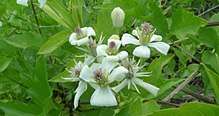Clematis ligusticifolia
| Clematis ligusticifolia | |
|---|---|
 | |
| Scientific classification | |
| Kingdom: | Plantae |
| Clade: | Angiosperms |
| Clade: | Eudicots |
| Order: | Ranunculales |
| Family: | Ranunculaceae |
| Genus: | Clematis |
| Species: | C. ligusticifolia |
| Binomial name | |
| Clematis ligusticifolia | |
Clematis ligusticifolia is a climbing, spreading vine with showy flowers. It is also known as Old-man's Beard and Yerba de Chiva, and Virgin's bower, (though Old-man's Beard may also refer to C. vitalba, and Virgin's bower may also refer to C. lasiantha). It is native to North America where it is widespread across the western United States in streamside thickets, wooded hillsides, and coniferous forests up to 4,000 feet.
It was called "pepper vine" by early travelers and pioneers of the American Old West. They used it as a pepper substitute to spice up food since real black pepper (Piper nigrum) was a costly and rarely obtainable spice. Like the rest of the genus Clematis, it contains essential oils and compounds which are extremely irritating to the skin and mucous membranes. Unlike Black Pepper or Capsicum, however, the compounds in clematis cause internal bleeding of the digestive tract if ingested internally in large amounts. The plants are essentially toxic. Despite its toxicity, Native Americans used very small amounts of clematis for migraine headaches and nervous disorders. It was also used as an effective treatment of skin infections.[1] A whole-plant hot water extraction was used to treat eczema, and a leaf compress is used to treat chest pain, sores, and boils.
References
Further reading
- Hill, Clyde; Hill, Steven; Lamb, Connie; Barrett, Thomas W. (1974). "Sensitivity of Native Desert Vegetation To SO2and to SO2and NO2Combined". Journal of the Air Pollution Control Association. 24 (2): 153–157. doi:10.1080/00022470.1974.10469907. ISSN 0002-2470.
- Shoemaker, R. A.; Müller, Emil (1963). "GENERIC CORRELATIONS AND CONCEPTS: BROOMELLA AND PESTALOTIA". Canadian Journal of Botany. 41 (8): 1235–1243. doi:10.1139/b63-103. ISSN 0008-4026.
- Turner, Nancy J (1984). "Counter-irritant and other medicinal uses of plants in ranunculaceae by native peoples in british columbia and neighbouring areas". Journal of Ethnopharmacology. 11 (2): 181–201. doi:10.1016/0378-8741(84)90038-2. ISSN 0378-8741. PMID 6387285.
- Borkent, Christopher J.; Harder, Lawrence D. (2012). "Flies (Diptera) as pollinators of two dioecious plants: behaviour and implications for plant mating". The Canadian Entomologist. 139 (02): 235–246. doi:10.4039/n05-087. ISSN 0008-347X.
- Fierke, Melissa K.; Kauffman, J. Boone (2006). "Invasive Species Influence Riparian Plant Diversity Along a Successional Gradient, Willamette River, Oregon". Natural Areas Journal. 26 (4): 376–382. doi:10.3375/0885-8608(2006)26[376:ISIRPD]2.0.CO;2. ISSN 0885-8608.